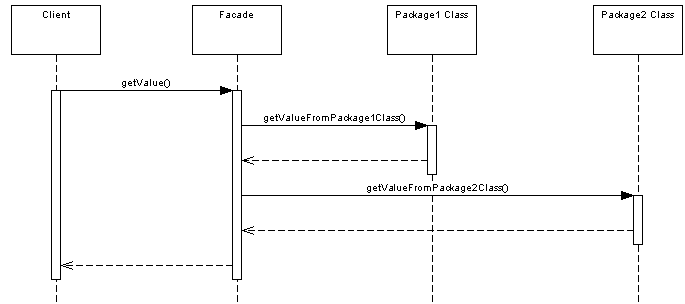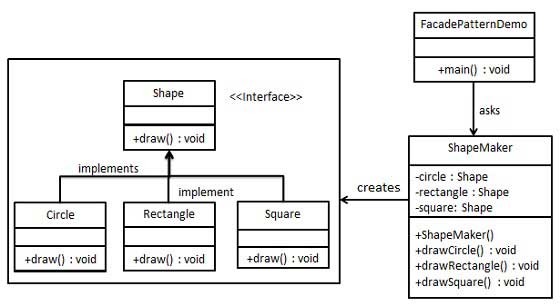Facade design pattern in Java and Python Development 07.01.2017
Structural Design Patterns provide different ways to create a class structure, for example using inheritance and composition to create a large object from small objects. Following design patterns come under this category.
- Adapter pattern
- Composite pattern
- Proxy pattern
- Facade pattern
- Bridge pattern
- Decorator pattern
- Flyweight pattern
Facade pattern provides a simplified interface to a complex subsystem.
The Facade pattern hides the complexities of the system and provides an interface to the client using which the client can access the system. It simplifies a client's interaction with a complex system by localizing the interactions into a single interface. A facade classes is used to provide a single interface to set of classes. As a result, the client can interact with a single object rather than being required to interact directly in complicated ways with the objects that make up the subsystem.
According to GoF Facade design pattern is:
Provide a unified interface to a set of interfaces in a subsystem. Facade Pattern defines a higher-level interface that makes the subsystem easier to use.
Facade design pattern is one among the other design patterns that promote loose coupling. It emphasizes one more important aspect of design which is abstraction. By hiding the complexity behind it and exposing a simple interface it achieves abstraction.
Mediator design pattern may look very similar to facade design pattern in terms of abstraction. Mediator abstracts the functionality of the subsystems in this way it is similar to the facade pattern. In the implementation of mediator pattern, subsystem or peers components are aware of the mediator and that interact with it. In the case of facade pattern, subsystems are not aware of the existence of facade. Only facade talks to the subsystems.
Important Points:
- Facade pattern is more like a helper for client applications; it doesn’t hide subsystem interfaces from the client. Whether to use Facade or not is completely dependent on client code.
- Facade pattern can be applied at any point of development, usually when the number of interfaces grows and system gets complex.
- Subsystem interfaces are not aware of Facade and they shouldn’t have any reference of the Facade interface.
- Facade pattern should be applied for similar kind of interfaces; its purpose is to provide a single interface rather than multiple interfaces that does the similar kind of jobs.
- Subsystem may be dependent with one another. In such case, facade can act as a coordinator and decouple the dependencies between the subsystems.
- We can use factory design pattern with Facade to provide better interface to client systems.
The following sequence diagram illustrates how the pattern is used by a client.
Java
We are going to create a Shape interface and concrete classes implementing the Shape interface. A facade class ShapeMaker is defined as a next step.
ShapeMaker class uses the concrete classes to delegate user calls to these classes. FacadePatternDemo, our demo class, will use ShapeMaker class to show the results.
Create an interface.
public interface Shape {
void draw();
}
Create concrete classes implementing the same interface.
public class Rectangle implements Shape {
@Override
public void draw() {
System.out.println("Rectangle::draw()");
}
}
public class Square implements Shape {
@Override
public void draw() {
System.out.println("Square::draw()");
}
}
public class Circle implements Shape {
@Override
public void draw() {
System.out.println("Circle::draw()");
}
}
Create a facade class.
public class ShapeMaker {
private Shape circle;
private Shape rectangle;
private Shape square;
public ShapeMaker() {
circle = new Circle();
rectangle = new Rectangle();
square = new Square();
}
public void drawCircle(){
circle.draw();
}
public void drawRectangle(){
rectangle.draw();
}
public void drawSquare(){
square.draw();
}
}
Use the facade to draw various types of shapes.
public class FacadePatternDemo {
public static void main(String[] args) {
ShapeMaker shapeMaker = new ShapeMaker();
shapeMaker.drawCircle();
shapeMaker.drawRectangle();
shapeMaker.drawSquare();
}
}
Python
import abc
class Shape(metaclass=abc.ABCMeta):
@abc.abstractmethod
def draw(self):
pass
class Rectangle(Shape):
def draw(self):
print("Rectangle::draw()")
class Square(Shape):
def draw(self):
print("Square::draw()")
class Circle(Shape):
def draw(self):
print("Circle::draw()")
class ShapeMaker:
def __init__(self):
self.circle = Circle()
self.rectangle = Rectangle()
self.square = Square()
def draw_circle(self):
self.circle.draw()
def draw_rectangle(self):
self.rectangle.draw()
def draw_square(self):
self.square.draw()
if __name__ == '__main__':
shape_maker = ShapeMaker()
shape_maker.draw_circle()
shape_maker.draw_rectangle()
shape_maker.draw_square()
Quote
Categories
- Android
- AngularJS
- Databases
- Development
- Django
- iOS
- Java
- JavaScript
- LaTex
- Linux
- Meteor JS
- Python
- Science
Archive ↓
- December 2023
- November 2023
- October 2023
- March 2022
- February 2022
- January 2022
- July 2021
- June 2021
- May 2021
- April 2021
- August 2020
- July 2020
- May 2020
- April 2020
- March 2020
- February 2020
- January 2020
- December 2019
- November 2019
- October 2019
- September 2019
- August 2019
- July 2019
- February 2019
- January 2019
- December 2018
- November 2018
- August 2018
- July 2018
- June 2018
- May 2018
- April 2018
- March 2018
- February 2018
- January 2018
- December 2017
- November 2017
- October 2017
- September 2017
- August 2017
- July 2017
- June 2017
- May 2017
- April 2017
- March 2017
- February 2017
- January 2017
- December 2016
- November 2016
- October 2016
- September 2016
- August 2016
- July 2016
- June 2016
- May 2016
- April 2016
- March 2016
- February 2016
- January 2016
- December 2015
- November 2015
- October 2015
- September 2015
- August 2015
- July 2015
- June 2015
- February 2015
- January 2015
- December 2014
- November 2014
- October 2014
- September 2014
- August 2014
- July 2014
- June 2014
- May 2014
- April 2014
- March 2014
- February 2014
- January 2014
- December 2013
- November 2013
- October 2013

